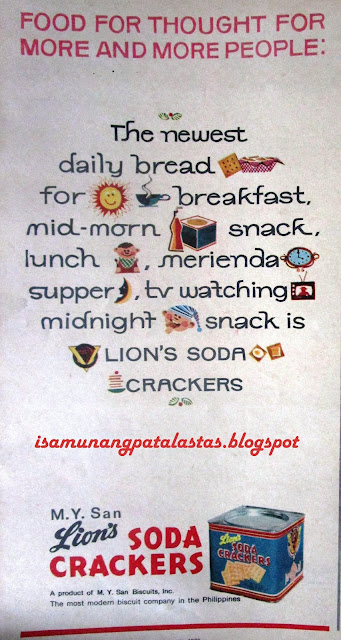To mark our
country’s hosting of the 30th Southeast Asian Games, let us pay
homage to our winning local athletes who are celebrated in these advertising
print ads from the past.
********
 |
| LYDIA DE VEGA, for Alaska, 1989 |
LYDIA DE VEGA, Athletics
SEA Games
Achievements:
GOLD: 200 m.
dash, 1981 SEA Games (Philippines)
GOLD: 400 m.,
1981 SEA Games, (Philippines)
GOLD: 200 m.
dash, 1983 SEA Games, (Singapore)
GOLD: 100
meter dash, 1987 SEA Games (Indonesia)
GOLD: 200
meter dash, 1987 SEA Games (Indonesia)
GOLD: Long
Jump, 1987 SEA Games (Indonesia)
GOLD: 100
meter dash, 1991 SEA Games (Philippines)
GOLD: 100
meter dash, 1993 SEA Games (Singapore)
GOLD: 200 meter dash, 1993 SEA Games (Singapore)
PRODUCTS ENDORSED:
ALASKA Milk, MILO Energy Drink
 |
| BEA LUCERO, for MILO, 1986 |
BEA LUCERO, Artistic
Gymnastics
SEA Games
Achievements:
GOLD: All-Around,
1987 SEA Games (Indonesia)
GOLD: Uneven Bars, 1987 SEA Games (Indonesia)
GOLD: Taekwondo,
Bantamweight, 1991 SEA Games (Philippines)
PRODUCT ENDORSED: MILO
Energy Drink, Ivory Soap
 |
| AIKO THOMSON, for MILO,1990 |
AKIKO THOMSON,
Swimming
SEA Games
Achievements:
GOLD: 100m.
backstroke, 1987 SEA Games (Indonesia)
GOLD: 100 m.
backstroke, 1991 SEA Games
GOLD: 200 m.
backstroke, 1991 SEA Games
SILVER: 200 m.
backstroke, 1987 SEA Games (Indonesia)
SILVER: 200 m.
backstroke, 1991 SEA Games
SILVER: 50 m.
freestyle, 1991 SEA Games
SILVER: 100 m.
freestyle: 1991 SEA Games
PRODUCT ENDORSED: MILO
Energy Drink
 |
| MONSOUR DE ROSARIO, for Rexona. 1987 |
MONSOUR DEL
ROSARIO JR., Tae Kwon Do
SEA Games
Achievements:
GOLD,
Taekwondo, Lightweight: 1987 SEA Games (Jakarta)
GOLD,
Taekwondo, Lightweight: 1989 SEA Games (Malaysia)
PRODUCT ENDORSED: Rexona
Anti-Perspirant
 |
| RICHARD GOMEZ, for BENCH, 1993. Photo: Bench |
RICHARD GOMEZ,
Fencing
SEA Games
Achievements:
GOLD, Men’s
Epee Team, 2005 SEA Games (Philippines)
PRODUCTS ENDORSED:
Bench, Coca-Cola, Diet Sarsi (with Dawn Zyleta) Lux (with Lucy Torres), BIC
ballpens (with Gretchen Barreto), Fortune Tobacco.
 |
| SAN MIGUEL BEER, 2009, Screen Grab: San Miguel TV, uploaded by San Miguel Pale Pilsen, 2009 |
EFREN “BATA” REYES,
Pool
SEA Games
Achievements:
BRONZE: 1 Cushion Carom, Singles: 2011 SEA Games (Jakarta),
2013 SEA Games (Myanmar), 2015 SEA Games (Singapore)
BRONZE: 3
Cushion Carom: 2011 SEA Games (Jakarta).
PRODUCTS ENDORSED: San Miguel Beer
SOURCES:
BENCH
San Miguel Ple Pilsen youtube
oldschoolads.blogspot, for Richard Gutierrez Coke ad, posted Jul. 5, 2009























































